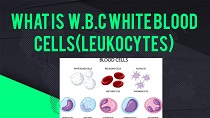white blood cells (leukocytes)
Definition:
White blood cells (leukocytes) are the cellular tissues of the body.
WBC Ratings:
They are divided into two major groups:
1. Granular leukocytes (granulocyte).
2. Agranular leukocytes (Agranulocytes).
1. Granular leukocytes:
They develop from the red bone marrow, are prominently granular.
in their cytoplasm and possess lobed nuclei. Three types of granules
Leukocytes are:
I. Polymorphonuclear neutrophils = 62.0%
ii Polymorphonuclear eosinophils = 2.3%
iii Polymorphonuclear basophils = 0.4%
2. Agranular leukocytes:
It is the second principle group of leukocytes, prepared from them
Lymphoid tissue, cytoplasmic granules are not seen:
i.Lymphocytes 30%
ii Monocytes 5.3%
Occasional plasma cells and platelets are fragments of the seventh fraction.
A tape of white somatic cells inside were bone marrow.
Total number of WBCs
I. Average = 7000/mm3
ii Range =4000-11000/mm3
Common values for each type of WBCS.
Polymorphonuclear neutrophils = 5400/mm3
Polymorphonuclear eosinophils = 275/mm3
Polymorphonuclear basophils = 35/mm3
Lymphocytes = 2750/mm3
Monocytes = 450/mm3
Chemical nature:
All WBCs are rich in nucleoprotein and also contain glycogen.
Cholesterol and lipids.
Life span of WBCs
Granulocytes = 4-8 hours in circulating blood
Monocytes = 4-5 days in tissues.
Lymphocytes = 10-12 hours in blood
months or maybe years in tissues as tissue macrophages. Months or years, counting on the body's want for these cells.
Sites of WBCs Production:
In the fetus:
WBCs are produced from the mesoderm of the yolk sac.
After birth:
Bone marrow = granulocytes and monocytes, and a few lymphocytes.
Lymph tissue = lymphocytes and plasma cells are mainly produced.
Lymph nodes in various lymphogenic organs including the thymus, spleen, and tonsils.
Functions of WBC:
i.phagocytosis:
It is a process by which neutrophils and macrophages engulf and destroy bacteria, viruses, and foreign particles. When bacteria invade the body, phagocytosis occurs by both neutrophils and monocytes.
ii. Formation of Antibody:
Lymphocytes form the ß and y fractions of serum globulin. Immune bodies are associated with y globulin. Therefore, lymphocytes play an important role in the body's defense mechanisms.
iii. Formation of fibroblasts:
Lymphocytes can be transformed into fibroblasts. Aids in the repair process at the site of inflammation.
iv heparin infusion:
Basophils secrete heparin, which prevents intravascular coagulation.
v. Cellular Defense:
Phagocytosis of large pathogenic microorganisms, such as protozoa and parasitic worms, releases inflammatory substances in allergic reactions.



0 Comments
Thank you